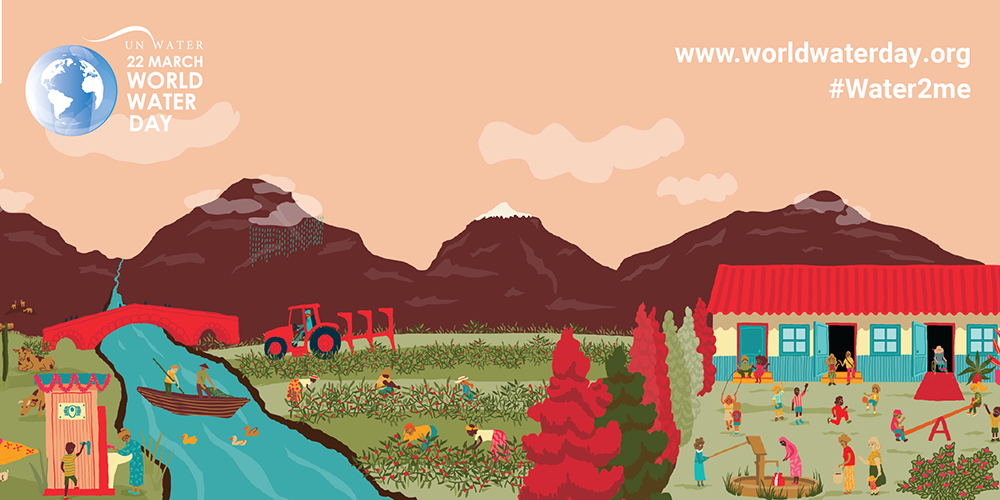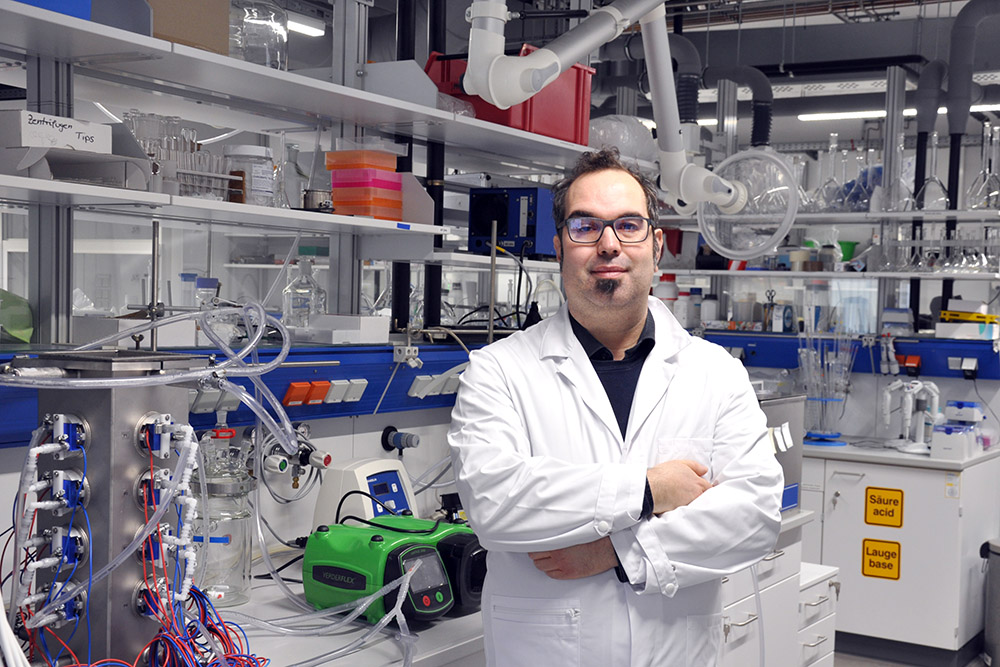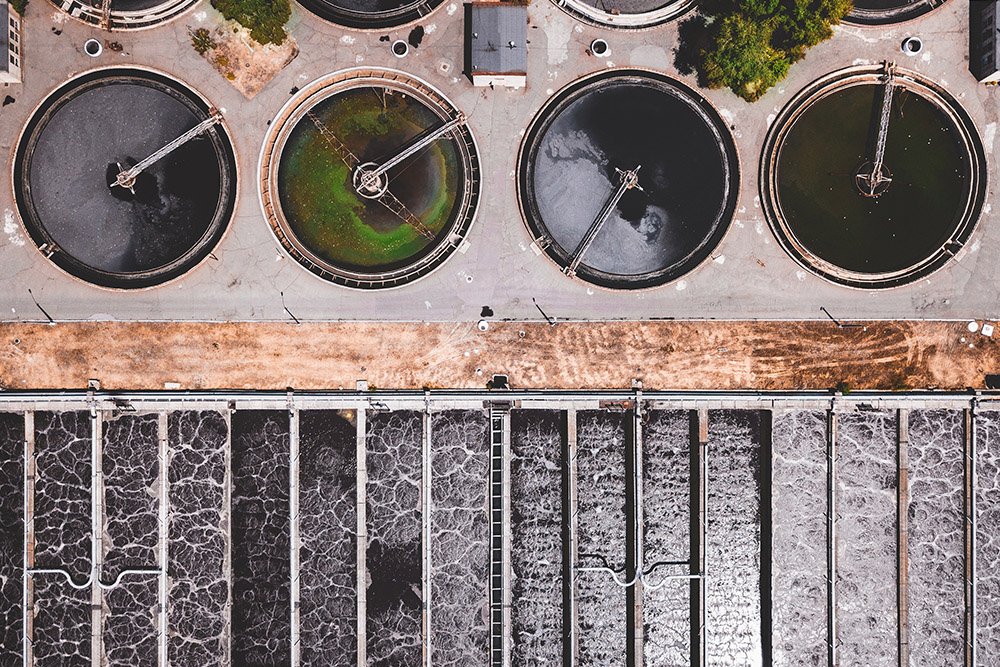Author: Annegret Kolarow
World Water Day 2021
On the value of water, power bubbles against micropollutants and sewage plants of the future – in conversation with Dr. Patrick Bräutigam

Even though the earth is known as the “blue planet”, only 2.5 % of its water is freshwater. And of this portion only a third can be used as drinking water. The resource is scarce and unevenly distributed: More than 2 billion people on earth live without access to clean water at home. To highlight this water crisis, the United Nations host World Water Day every year on March 22, accompanied by campaigns and activities of governmental and non-governmental organizations. We talked to Dr. Patrick Bräutigam, group manager of the working group “Reaction Engineering Water” at IKTS and head of the group “Water Technology” at the Friedrich-Schiller-Universität Jena about how research institutions can contribute to the fight against the water crisis, why the resource must also be protected in industrialized countries and which technologies will become relevant in the future.
Dr. Bräutigam, the theme of this year’s World Water Day is “Valuing Water”. What does water mean to you personally?
Water is essential – and not only for me, but for all people, all creatures on earth. It is a source of nourishment and also a habitat. At the same time, however, it is an industrial raw material that is being used, which leads to an increasing scarcity and pollution. Water is therefore a very valuable commodity that must be protected.
"Research institutions can make a big contribution – for example, with various technologies that clean contaminants from polluted water, including those that were not known to exist until recently."
More than 2 billion people live without access to clean water. The United Nations has therefore declared to achieve clean drinking water and sanitation for all by 2030 as one of its Sustainable Development Goals. What contribution can research institutions like the Fraunhofer-Gesellschaft make here, and what political framework do they need to achieve this?
The Fraunhofer-Gesellschaft and research institutions as a whole, can make a big contribution – for example with various technologies that clean contaminants from polluted water, including those that were not even known to exist until recently. We can develop analytical methods and use sensors to measure which pollutants occur when and where. This data is incorporated into concepts for new processes, which above all should operate in an energy-efficient manner. After all, we must never forget that the costs of their use are shouldered by the general public. On the other hand, technologies can contribute to the industrial use of water, so that industrial processes use the resource sparingly or recirculate the water almost completely, thus avoiding the need for new freshwater resources. There are various technical approaches to cleaning these process waters that need to be developed and implemented on a large scale. Here, research can contribute a great deal. As far as the political framework is concerned, research, which is per se open-ended, requires financial support. But regulations also need to be made at the legislative level. One example: there is a large number of micropollutants. To date, however, it is not clear whether and to what extent reference substances will be defined. A clear stance, even if it is difficult, would be helpful in process development.
Even in industrially developed countries, drinking water is impacted. You mentioned micropollutants. Can you explain why these substances have so far been insufficiently removed by current water treatment processes?
Until a few years ago, we were not aware of these substances. This is also because until then it was not possible to measure the low concentrations of these substances. In addition, wastewater treatment plants are not currently designed to separate such pollutants. Their goal is to remove carbon, nitrogen and phosphorus. To do this, they fall back on technologies from the 1950s, which were developed when, for example, the algae formation in water bodies caused by phosphorus was recognized. So, there are always development steps in this field. Now the so-called fourth treatment stage is being discussed, in which micropollutants are to be removed. These are substances that are only present in very low concentrations but may well have an effect even in these concentrations. To illustrate this, you can imagine it as if a lump of sugar is dissolved in a swimming pool. The substances are, for example, pharmaceuticals, pesticides, industrial chemicals or dyes that have an effect on the ecosystem even in their low concentration – for example, hormones that lead to a feminization of the fish population and thus to infertility. To remove these substances, new processes are needed which conventional wastewater treatment plants do not have.
In your research, you are working on what is known as cavitation. How does this process work and how can it be used in the removal of micropollutants?

In cavitation, we use gas-filled bubbles in the water that first form and then collapse. The bubble formation is created by negative pressure, similar to opening a sparkling water bottle. Technically, we use hydraulic currents or ultrasound for this purpose, also to force the bubbles to collapse. In a very short time, their volume is then reduced by a factor of 12,000, virtually from a watermelon to a cherry stone in just a few microseconds. This generates very high temperatures and pressures: up to 5000 Kelvin and 1000 atmospheres. These are conditions as known only from the sun and which are capable of splitting water. This is how we turn water into the actual reactive substance: the so-called OH radical, which is highly reactive and can thus break down micropollutants.
"Via process coupling, we want to completely remove all pollutants, be faster and save energy in the process."
You combine cavitation with other processes and integrate sensors and machine learning.
Cavitation is fundamentally suitable for the degradation of micropollutants. However, because it requires a lot of energy, we combine it with other processes and find high synergies in this. For example, in coupling with ozonation, an established process for water treatment with ozone, we can achieve water purification much faster: from about 1 to 1.5 hours with ozonation to only ten minutes in coupling with cavitation – and with the same energy input. However, the goal is not only speed but also that all pollutants are completely removed. Current processes do not achieve the complete elimination of all compounds. We want to use process coupling to remove all pollutants, be faster and save energy at the same time. We have implemented this in part on a laboratory scale and want to do the same on a larger scale. We use sensors to obtain precise information about the degree of contamination of water. Up to now, this has been laboriously tested with water samples, which only provides results with a time delay. This information can be used, for example, to adjust the performance of the wastewater treatment plant during operation and make the process as a whole much more energy-efficient. Lastly, treatment plants can also be seen as learning systems that can adapt. Based on socio-geographical data, time of day and season, or infection levels, we can make predictions about the concentration of certain substances or derive recommendations about which processes are best suited for which substances. Based on this, we can also advise industry on which chemicals would be more ecologically sound to use or even develop completely new, more easily degradable chemicals.
You are currently building up your research group “Reaction Engineering Water”. How does it fit into the still young IKTS business division water and which synergies do you anticipate?
My group works mainly on a mechanistic or molecular level. The aim is to develop completely new materials, methods and processes, initially on a laboratory scale, in order to test their feasibility. We are currently working on cavitation, plasma techniques and combination processes, among others. There are many connecting factors in the business division for scaling up this work and coupling it with other processes, such as biological or electrochemical processes. Ceramic membranes could also be used to concentrate trace contaminant concentrations, allowing lower volumes to be treated more cost-effectively. The group thus fits in very organically because it adds oxidative processes to the portfolio.
"There is a change in awareness at all levels, combined with a willingness to do something, and we can support that with our technologies."
Finally, venture a look into the future: the year 2030 is set for the UN's Sustainable Development Goals – where do you see your own research in that year?
You should aim high, and that is what we are doing. Our processes have good chances in the industrial context. I am also noticing that wastewater treatment plant operators are looking more closely at new processes. We are getting more and more direct inquiries from them. It is more proactive than it used to be. The public is also inquiring: “What about pharmaceutical residues? How dangerous are they? Don’t we need to get that out?” And that is important, because these technologies cost more money to begin with. The willingness of the public to pay more for clean water accompanies this research. But I am hopeful, because there is a change in awareness at all levels, combined with a willingness to do something, and we can support that with our technologies. So, I hope that in 2030 we will see some of our technologies, be it sensor technology or new processes for micropollutant removal, in use and contributing to the further development of water technologies.
Thank you for the conversation!
Further information
- Group page "Reaction Engineering Water"
- Business Devision Water
- Industrial solutions brochure Water and waste water technology
- More on World Water Day
- More on the United Nation’s Sustainable Development Goals
- More on water research at the Friedrich-Schiller-Universität Jena: CEEC und Lehrstuhl für Technische Umweltchemie
Stay informed: You are welcome to subscribe to our newsletter, read our other blog articles and follow us on LinkedIn, Instagram and YouTube.
